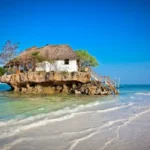The enchanting state of Rajasthan is cocooned in a rich culture and ancient history. Its people are infused with a fierce sense of pride in their heritage and culture.
From majestic palaces to shimmering lakes, Rajasthan offers some breathtaking sights. Indulge in a culinary adventure in Jaipur or feast at the famed Choki Dhani model village resort.
Jaipur
Jaipur, the capital city of Rajasthan, is filled with saffron or pink-coloured buildings and is a top tourist destination. Besides being home to the UNESCO World Heritage Site Jantar Mantar, it is also popular for its historic palaces like Hawa Mahal and Jaigarh Fort. It is a great place to learn about Rajasthani culture, especially its folk music and dance. It is also famous for its handicraft, especially bhandhani, block printing, kinari, gota, and silver jewelry and kundan.
While Jaipur’s architecture draws many visitors, the city is also known for its markets, where one can find a wide range of products. The most popular market is Bapu Bazaar, where tourists can purchase a variety of textiles, including sarees with beautiful designs and patterns. It is also a great place to purchase traditional Rajasthani shoes called Jodhpuri Juttis, which are ideal for adding a touch of royalty and Indian culture to any outfit.
In terms of climate, most of Rajasthan is a desert, with only a small percentage of the state covered in forest areas. This makes it a very dry region, and the lack of rain has made food crops such as wheat, barley, cotton, and oilseeds essential to the economy. Other important agricultural products include opium and wool. Tribal communities, including the Banjara, a historically itinerant group that performs services in agriculture and trade, are found throughout the state.
Jodhpur
The second-largest city in Rajasthan, Jodhpur was once the seat of a princely state called Marwar. Now it’s the center of a bustling metropolis with a dazzling collection of palaces, forts, and old towns. The city’s heart beats around the mighty Mehrangarh Fort, which rises four hundred feet above the tumultuous streets of Jodhpur’s historic district. The fort’s artillery-lined ramparts offer stunning views of the tumultuous blue city below, while its museum showcases period rooms and galleries.
Also worth visiting is the impressive Toorji Ka Jhalra Bavdi, an intricately carved step well built in the 18th century by a wealthy Maharaja as a source of water for his citizens. The structure is surrounded by a series of arches and is a beautiful example of Rajput architecture.
Besides its spectacular temples, museums and forts, Jodhpur has plenty to offer the foodie, including mawa kachori, apricot halwa and other delicious sweets. It is famous for its annual festivals and flamboyant cuisine, as well as its exquisite handicrafts, folk dances, and music.
The city is the seat of the Rajasthan State High Court and the University of Jodhpur. It is also home to an air force base and the ruins of Mandore, the former capital of Marwar. The southwestern part of the city is bounded by the Thar Desert, which can be seen from atop Mehrangarh Fort’s towering walls.
Udaipur
Located on the banks of Lake Pichola, the picturesque Udaipur is a perfect blend of old and new. The pristine lakes, soaring hills and ancient Aravalli valley provide the perfect setting for its breathtaking palaces and gardens. This is why it’s also known as the “Venice of the East”.
The city was built in the 16th century by Maharana Udai Singh II, who moved his capital here from Chittorgarh to escape constant attacks by enemies. The city is a showcase of the rich Rajput culture with its palaces, lakes and forts.
Its unique lake system enables the city to have an adequate supply of water for drinking, agriculture, industries and groundwater recharge. There are three lakes in its upper catchment area, one lake downstream and six lakes within the city limits. The city’s lakes are protected by a network of palis (a series of walls).
Monsoon Palace, also known as Sajjan Garh is a white marble temple built by Maharana Jagat Singh I and is located on Bansdara peak of the Aravalli range. It serves as a scenic spot and is an important astronomical center.
There is also a cultural institute named Bharatiya Lok Kala Mandal, which displays a collection of Rajasthani culture including dresses, tribal jewelry and turbans, dolls, masks and musical instruments. It is a great place to learn about the different social stigmas of the region and understand the life of people in the city.
Jaisalmer
With its grand forts, palaces and havelis, Rajasthan has been home to a courageous dynasty of Rajputs. Their battle scarred legacy is imbued proudly and conventionally in the townscapes of the land. However, there is also a lot to explore in this fascinating land beyond the magnificent edifices of its royal past.
A visit to Jaisalmer is a treat for history and culture buffs. Stroll through its winding lanes, and lose yourself in its 12th-century temples and intricately carved havelis. Take in the smell of incense rising from the sanctuaries at Bada Bagh, where royal cenotaphs (chhatris) stand tall and reverent.
The city is also known for its camel-riding and desert safari opportunities. Whether you choose to take a jeep-safari or enjoy a camel ride over the never-ending sleek stretch of desert, a visit to Jaisalmer is sure to leave you spellbound.
A trip to Jaisalmer is also incomplete without trying its spicy cuisine. Try the Ker Sangri, a preparation made with desert beans, or indulge in the succlent boneless preparation of chicken called Murg-e-Subz. To satisfy your sweet tooth, make sure to finish off your meal with a plate of Ghotua Laddoo. A visit to the city is also complete with a tour of its Thar Heritage Museum located in Gandhi Chowk. The museum has an exciting collection of items from the past that are sure to interest visitors.

